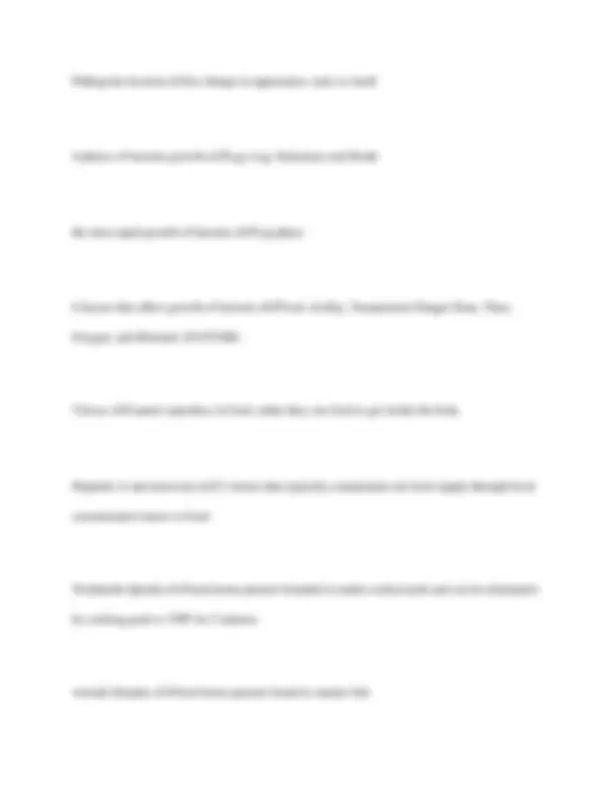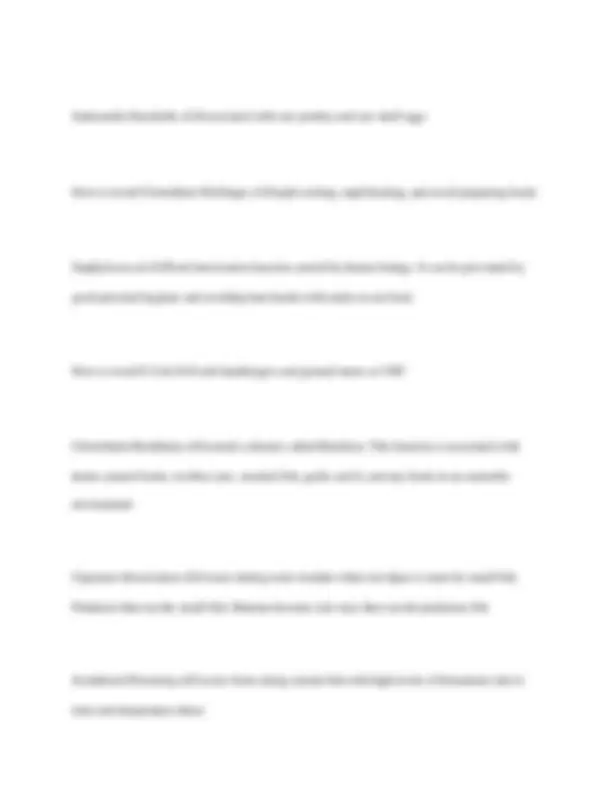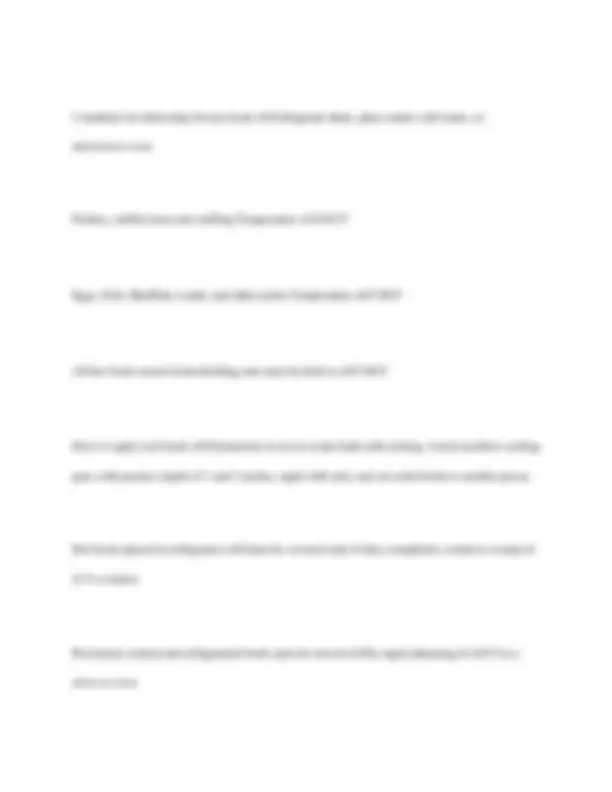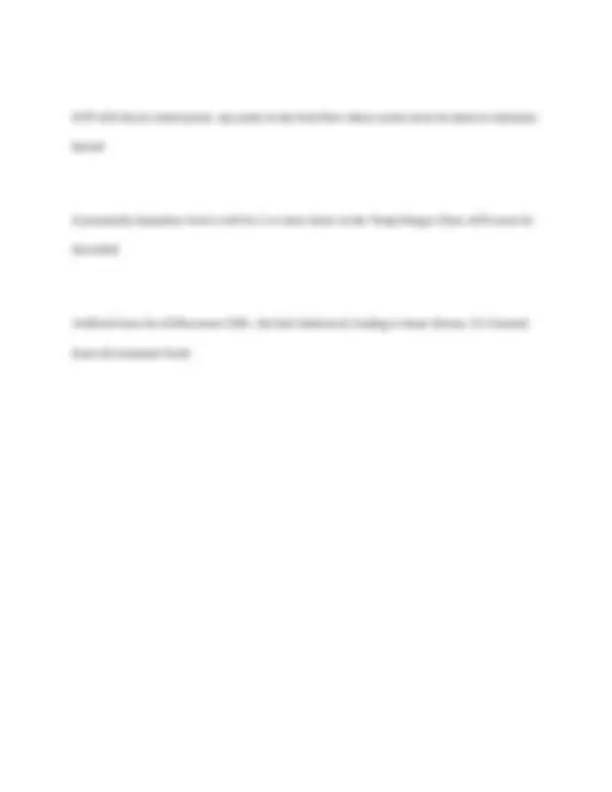






Study with the several resources on Docsity

Earn points by helping other students or get them with a premium plan


Prepare for your exams
Study with the several resources on Docsity

Earn points to download
Earn points by helping other students or get them with a premium plan
Community
Ask the community for help and clear up your study doubts
Discover the best universities in your country according to Docsity users
Free resources
Download our free guides on studying techniques, anxiety management strategies, and thesis advice from Docsity tutors
A comprehensive overview of essential food safety practices and regulations for food handlers. It covers topics such as food temperature control, cross-contamination prevention, proper sanitation, and the importance of haccp principles. Particularly useful for individuals preparing for food handler certification exams or seeking to enhance their knowledge of food safety.
Typology: Exams
1 / 8

This page cannot be seen from the preview
Don't miss anything!





Potentially Hazardous foods ✔✔any food that supports the rapid growth of microorganisms
Three thermometers used for measuring food temperature ✔✔Bi-metallic stem (0-220), thermocouple, thermistor(digital)
Raw Shell Eggs Temperature ✔✔45 F
Smoked Fish Temperature ✔✔38 F or below because of the bacteria Clostridium botulinum
All Refrigerated Food except eggs/smoked fish Temperature ✔✔41 F or below
Reasons Canned Products Must be Rejected ✔✔dents in seams, swelling, severe rust, leakage or no label. Home-canned foods are unacceptable
Vacuum Packaging of any food product in retail food establishment is ✔✔Prohibited by law unless special authorization is obtained through the Department of Health
FIFO ✔✔First In First Out- used to implement date products
All Food must be stored at least ✔✔6 inches off the floor
To Prevent Cross Contamination ✔✔raw food must be placed under cooked food
Food for storage must be covered and stored in ✔✔Vermin-proof containers
The Three Main Food Hazards ✔✔physical, chemical, biological
Physical Hazards ✔✔glass fragments, metal etc.
Chemical Hazards ✔✔pesticide, cleaning agents, prescription medicine
Biological Hazards ✔✔bacteria, viruses, parasites and fungi
Salmonella Enteritidis ✔✔associated with raw poultry and raw shell eggs
How to avoid Clostridium Perfringes ✔✔rapid cooling, rapid heating, and avoid preparing foods
Staphylococcal ✔✔food intoxication bacteria carried by human beings. It can be prevented by good personal hygiene and avoiding bare hands with ready-to-eat food.
How to avoid E-Coli ✔✔cook hamburgers and ground meats at 158F
Clostridium Botulinum ✔✔caused a disease called Botulism. This bacteria is associated with home-canned foods, swollen cans, smoked fish, garlic and il, and any foods in an anaerobic environment
Ciguatera Intoxication ✔✔occurs during warn weather when red algae is eaten by small fish. Predators then eat the small fish. Humans become sick once they eat the predatory fish
Scombroid Poisoning ✔✔occurs from eating certain fish with high levels of histamines due to time and temperature abuse
3 methods for defrosting frozen foods ✔✔refrigerate them, place under cold water, or microwave oven
Poultry, stuffed meat and stuffing Temperature ✔✔165 F
Eggs, Fish, Shellfish, Lamb, and other meats Temperature ✔✔140 F
All hot foods stored in hot-holding unit must be held at ✔✔140 F
How to rapid cool foods ✔✔immersion in an ice-water bath with stirring, 4 inch swallow cooling pans with product depth of 1 and 2 inches, rapid chill unit, and cut solid foods to smaller pieces
Hot foods placed in refrigerator ✔✔must be covered only if they completely cooled at a temp of 41 F or below
Previously cooked and refrigerated foods must be served ✔✔by rapid reheating of 165 F in a stove or oven
bathrooms for patrons ✔✔must be provided if there are 20 seats or more in a dining area
100 PPM Chlorine based sanitizing solutions ✔✔add 1 ounce bleach and 1 gallon of water and used for wiping, spraying or pouring
Wiping cloths ✔✔must be stored with solution strength of 50 PPM
Rat droppings ✔✔are a critical violation
Best method to eliminate flies and roaches ✔✔proper cleaning and sanitizing
HACCP and 7 methods of this ✔✔Hazard Analysis and Critical Control Point. Identify hazard, determine critical control point, set up critical limits, monitor CCP, take corrective actions, verify system is working, and record keeping
HACCP ✔✔it is a system of food safety, which is mainly concerned with control of harmful microorganisms
CCP ✔✔citical control point- any point in the food flow where action must be taken to eliminate hazard
if potentially hazardous food is left for 2 or more hours in the Temp Danger Zone ✔✔it must be discarded
Artificial trans fat ✔✔increases LDL- the bad cholesterol, leading to heart disease. It is banned from all restaurant foods